A JOZIAN IN ITALY
When in Friuli-Venezia Giulia, eat gnocchi, not pasta
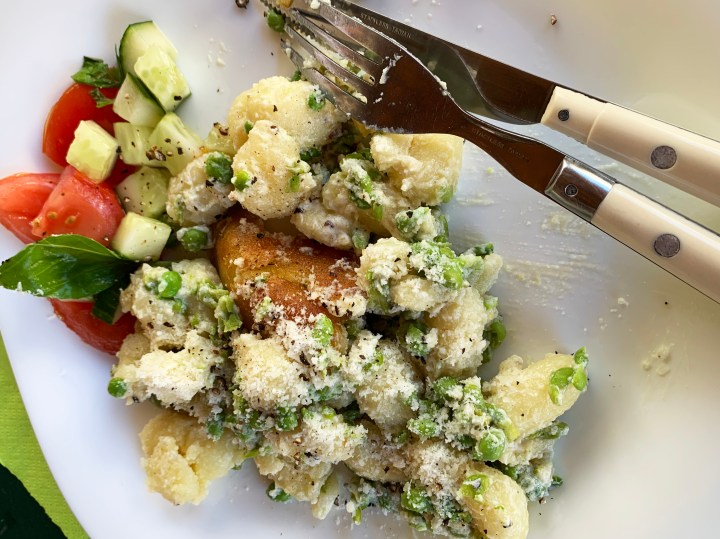
I feel so far from Jozi at many times of the day, comparing local produce and practice in this food-conscious part of Italy.
It’s for the pigs, my sister’s neighbour corrects her curtly, when she excitedly points out a stray mielie plant and raves about perhaps eating South African sweetcorn again. It’s for pigs when it is kernels or cobs, not polenta. The last is acceptable, very acceptable round here, where pasta as we know it, is not.
We might also think that, because the Italian for “food” is “pasto”, everyone in Italy eats pasta, most likely spaghetti. Not here and not in other places I know, such as Tuscany. There they eat one sort, egg pappardelle, delicious I know with hare, but generally their carbs of choice are rice or polenta.
In Venice, don’t imagine you’ll be plied with noodles because Marco Polo was supposed to have introduced them from the east. That’s a fairy story. What he really did was repeat the trade and diplomacy journey of his father and uncle, in their company, to the court of Genghis Khan’s grandson and returned via present day Turkey and Greece. He would have carried letters and some forms of payment back but no noodles. The Venetians eat rice anyway. Think risi e bisi and risotto seppie cooked in the cuttlefish’s black ink.
Where we are, in Friuli-Venezia Giulia, right next to the Veneto region and the Adriatic, people particularly like potato gnocchi or risotto. Where there is any pasta in this region, it’s the stuffed sort and in big sizes. My sister Mags and I also seem to eat quite a bit of gnocchi, once with the tiniest pisellini, half the size of our baby peas, slightly crushed with garden herbs, butter and seasoning.
In both little supermarkets around here are two great convenience buys, I find. One is frozen spinach in sensibly-sized blocks so that you only need to cook as much as you like, instead of the lot or having to smash off a section with a half brick as I’ve done back home. The other one is parmigiano also in neat blocks, much smaller and not frozen of course, in a bag. One little block would be grated over a dish or all the eaters can have one each, to grate over their own food at the table. Naturally it’s lots cheaper here too, even the very aged parmigiano. Parma is not far away.
Most locals here start the day with a milky coffee or the thick cappuccino they have here and something bready or sweet dipped into it. Sometimes it’s just a piece of the bread from the day before but there are hundreds of kinds of biscuits in the shops, probably for this purpose. A cornetto seems to be another favourite for dipping, like a croissant. People often check their watches or phones before they order cappuccino in bars or cafes. After 10 in the morning, it’s just not done. An espresso is to be drunk instead, often with another sweet nibble that arrives on the saucer.
People are very conscious of these do’s and don’ts. Bella figura or the consciousness of dress and behaviour is something to consider. After the 10th of September, I heard it said, men no longer wear white clothes and women abandon the summery dresses for more autumnal stuff. I am aware of the stares because my travel wardrobe doesn’t allow for two seasons. At the equinox, pretty much always, when I am here, the weather turns cold anyway and I have to wear a jersey over my disapproved clothes.
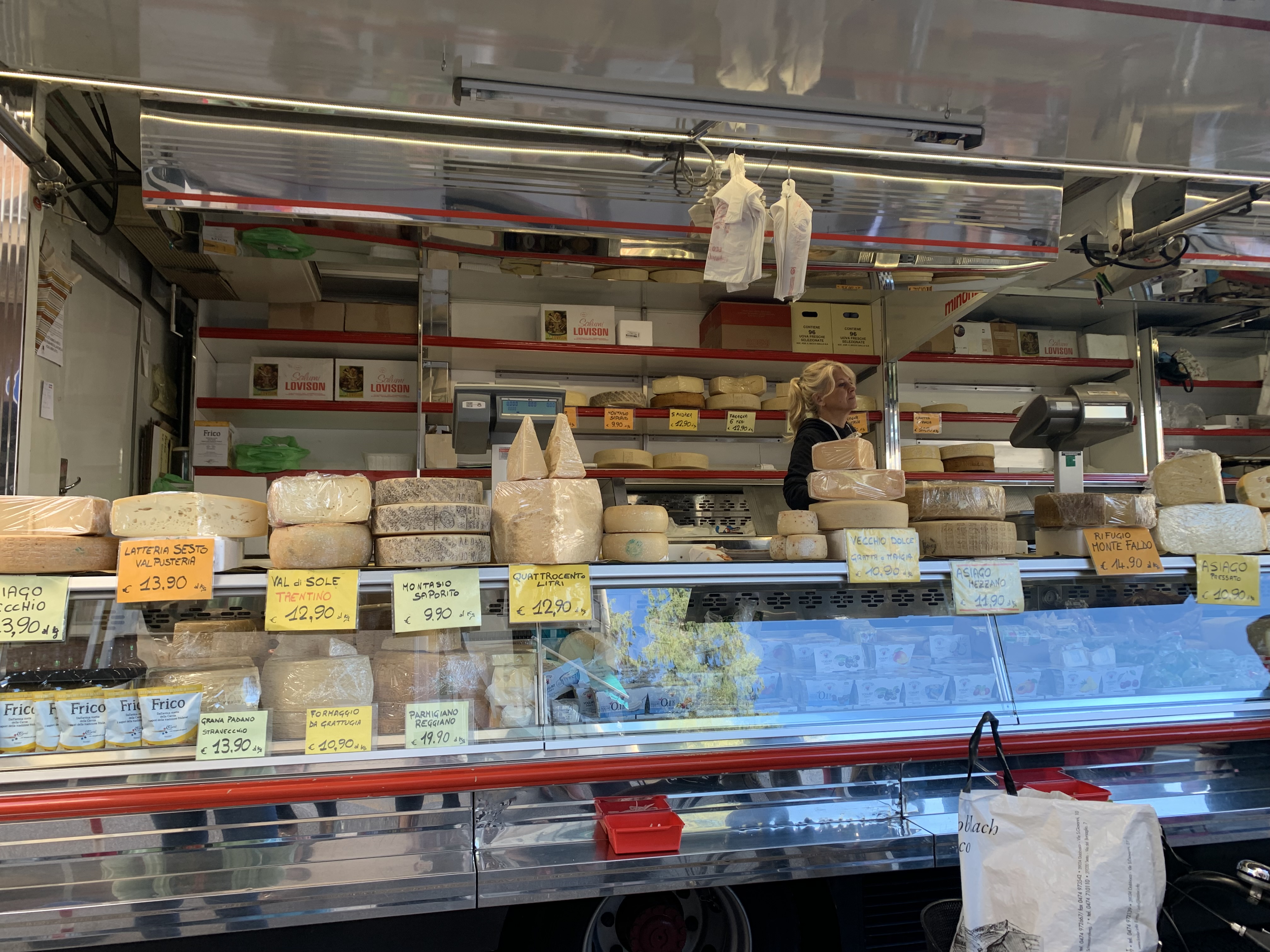
We’re going through as many local cheeses as we can. (Photo: Margot Patterson)
At my sister’s house we just start the day with espresso and she lays out a small table with hardboiled eggs, a local ham like the world-famous San Daniele of very close by and a local cheese. We’re going through as many local cheeses as we can this way and there are lots. I used to think it was just Montasio and Asiago. There’s bread, usually something sourdough or rye and impressively artisanal from a local market and maybe even some mulberry jam from the neighbour. There are a few local fruits, nectarines and peaches at present, and whole yoghurt. With breakfast choices like these under the belt, I can cycle anywhere on my trusty white sit-up-and-beg bike, similar to everyone else’s.
I’ve seen locals taking a child to the local junior school in a sort of wooden wheelbarrow attachment in front of the bicycles. The kid sits there wearing a crash helmet. All the pavements and roads are marked out for cycles and cyclists cross the roads at zebra crossings, at which car drivers always stop. I love it.
One day, Fabiola, the beautiful Venetian char who often cleans my sister’s place, arrived by bicycle (she also has an expensive and spotless white motorbike) with a jar of something she’d made. Fabiola earns quite a bit, as do the other local chars. She has a degree from Venice university but Italian jobs are scarce. My sister is such a neatness and cleanliness freak, I can never imagine what could possibly need to be done by this glam woman in long gloves.
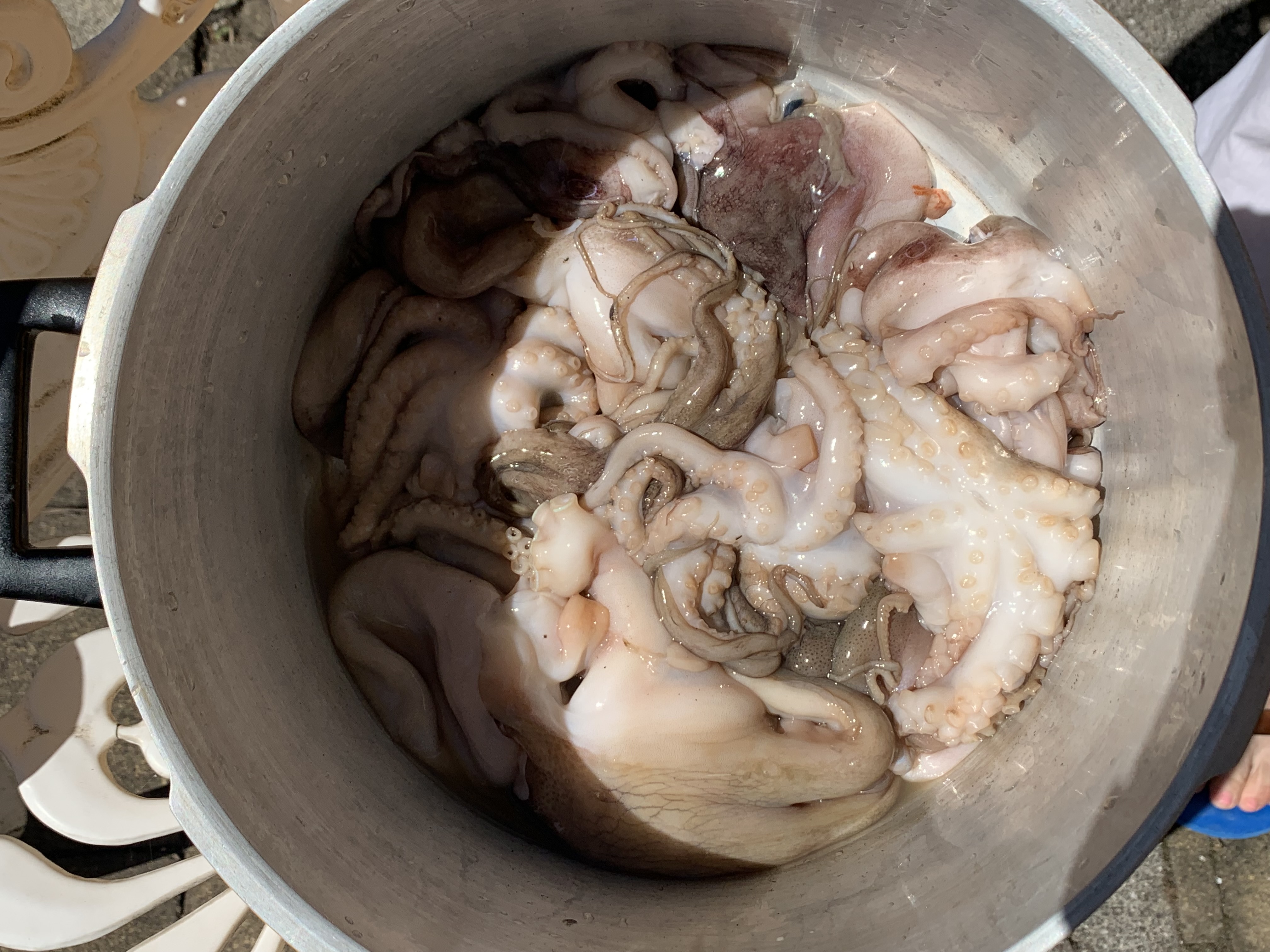
We’d been cooking octopus. (Photo: Margot Patterson)
One previous day Fabiola had walked in and sniffed. We’d been cooking octopus and she insisted on cleaning the walls from top to bottom, the curtains being washed and rehung, the counters stripped and scrubbed. She kept sniffing the room for vestiges of the rather nice smell, I’d thought. Many people have an outside kitchen as well for just this sort of reason, Mags too, next to her grillia on her piazza and under a roof. We use it now for frying and fish things. Fabiola costs a lot per hour.
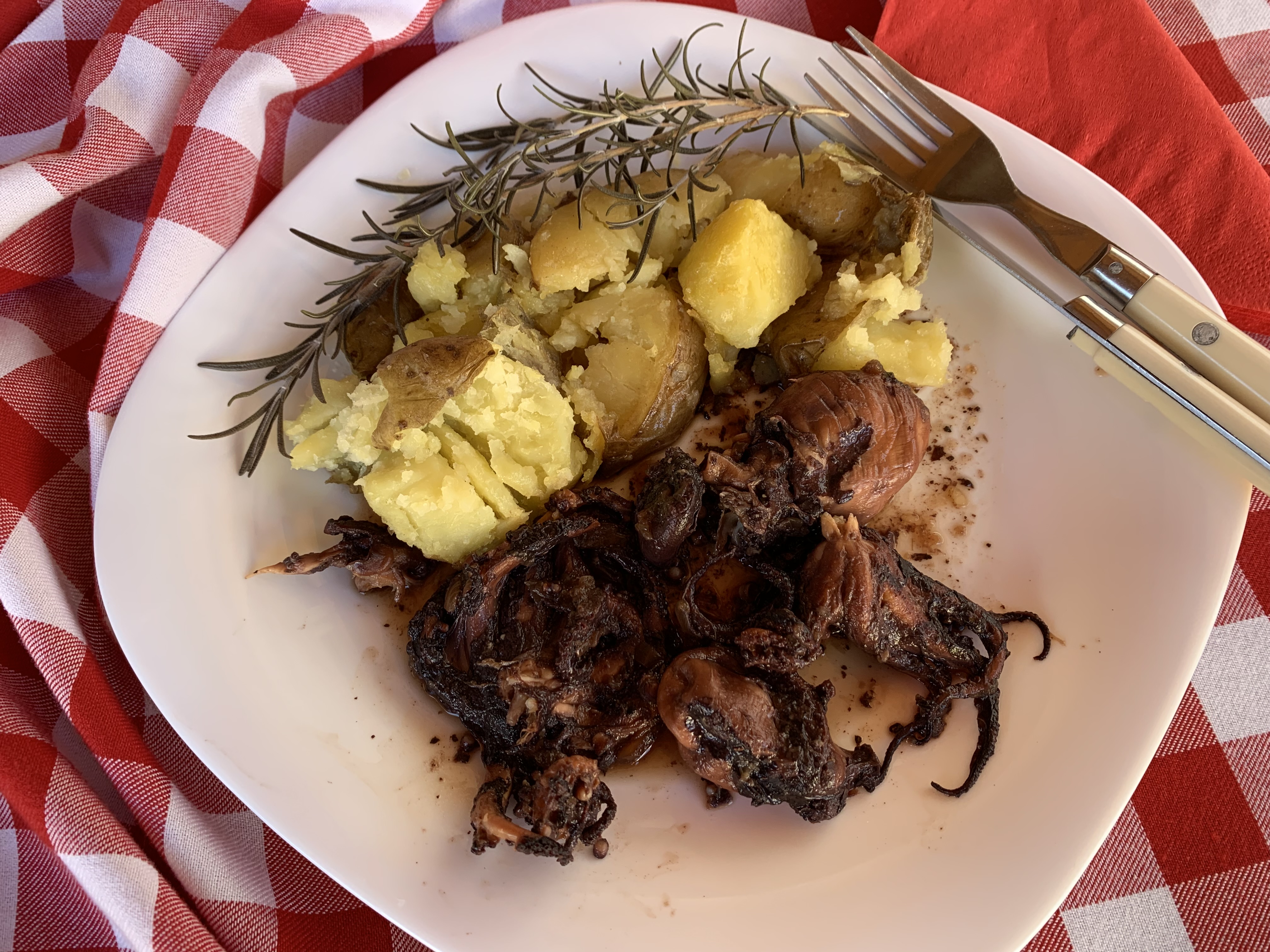
Now we use the outside kitchen for seafood things, like octopus. (Photo: Margot Patterson)
However, this was a food visit. She asked If I remembered the green tomato marmellata she’d once spoken of. It was four years ago and I’d been intrigued. Mags and I were asked to bring out onto the patio table some cheese and some lemon zest, she said. Then we settled down to taste this unforgettably delicious olive coloured jam with a sprinkling of lemon zest on pieces of cheese.
The cheese we had was a Veneto cheese ripened under prosecco. We also had one with a dark red rind that had undergone the same treatment under one of the Veneto reds. Our prosecco cheese was the outstanding one with this sweet-tart green tomato relish that Fabiola had made. I couldn’t stop tasting it under the striped yellow awning, to the sound of paler green doves cooing their special Italian message in between the ringings of various church bells in the distance.
An evening walk away from my sister’s place is a splendid restaurant, the Al Braciere, run by a man called Ermes. When you arrive and before you are seated in the actual restaurant, the question is meat or fish? In Italian. We have never said meat. Every course from then is a fish one, except for the pudd. A great fuss is made especially with the secondo, the main course, where the tall, dark-haired and quite severe-looking manageress fillets our choices of fish on a trolley next to our table, with a pair of forks.
It’s a fascinating experience of course and an introduction to a whole lot of small tastes of fish, especially during the antipasto course, including my favourite item, mantecato. It’s a speciality of this region and the Veneto, made of cod, the flesh whipped with olive oil and a little garlic, into a light and fluffy almost mayonnaise-like consistency. I have taken to making it with snoek in South Africa.
We always walk back from the restaurant, under the moon, discussing the fish tastes we didn’t know and reliving the ones we did.
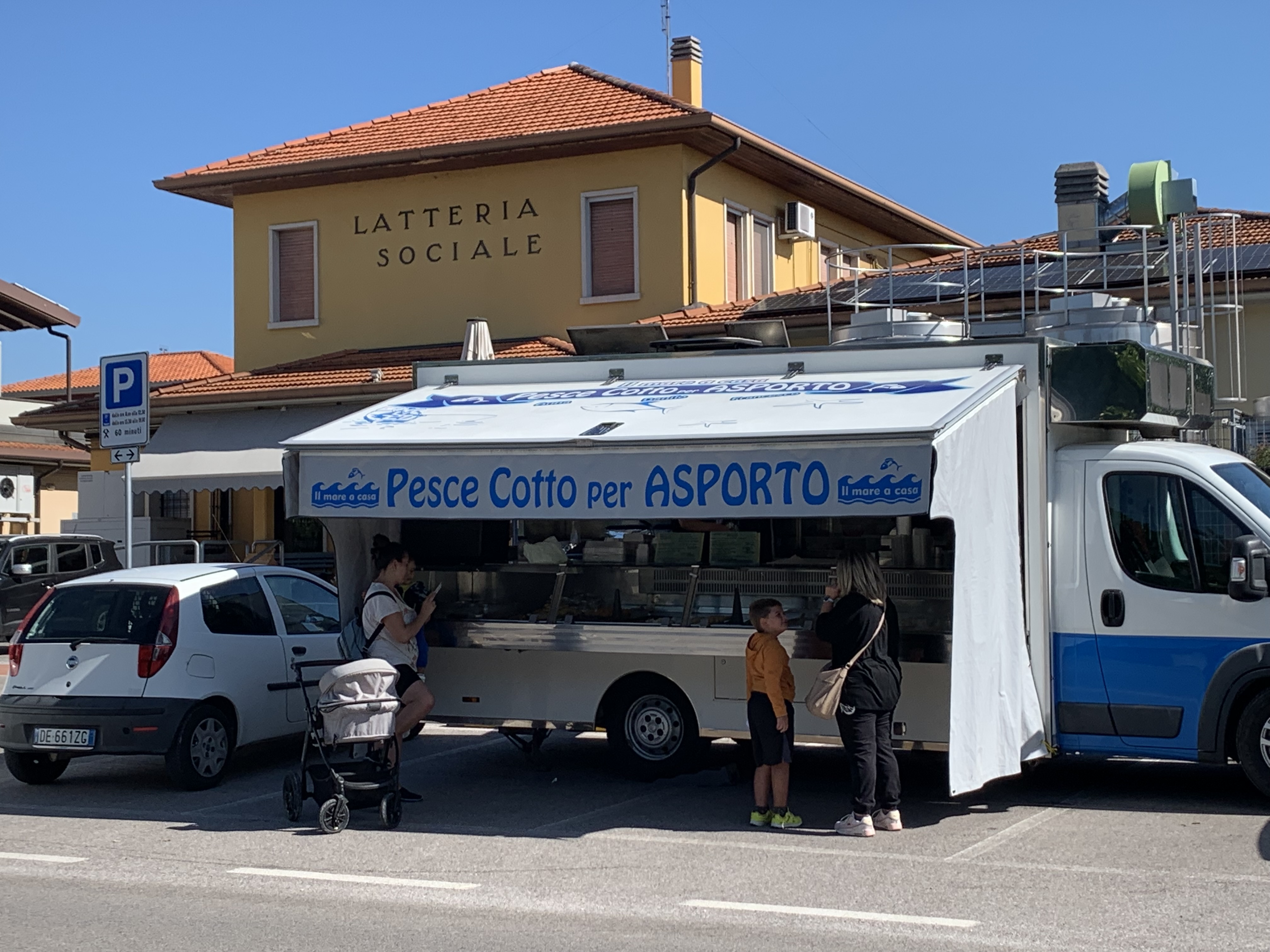
This time we agreed we could take advantage of the Caorle caravan for freshly cooked fish. (Photo: Margot Patterson)
This time, we agreed we can never have enough local fish and realised that we could take advantage of the local caravan from Caorle, a local seaside place, that parks a block from my sister’s house. It sells freshly-cooked fish on Sundays. There are many other people who don’t want to cook fish in their own homes.
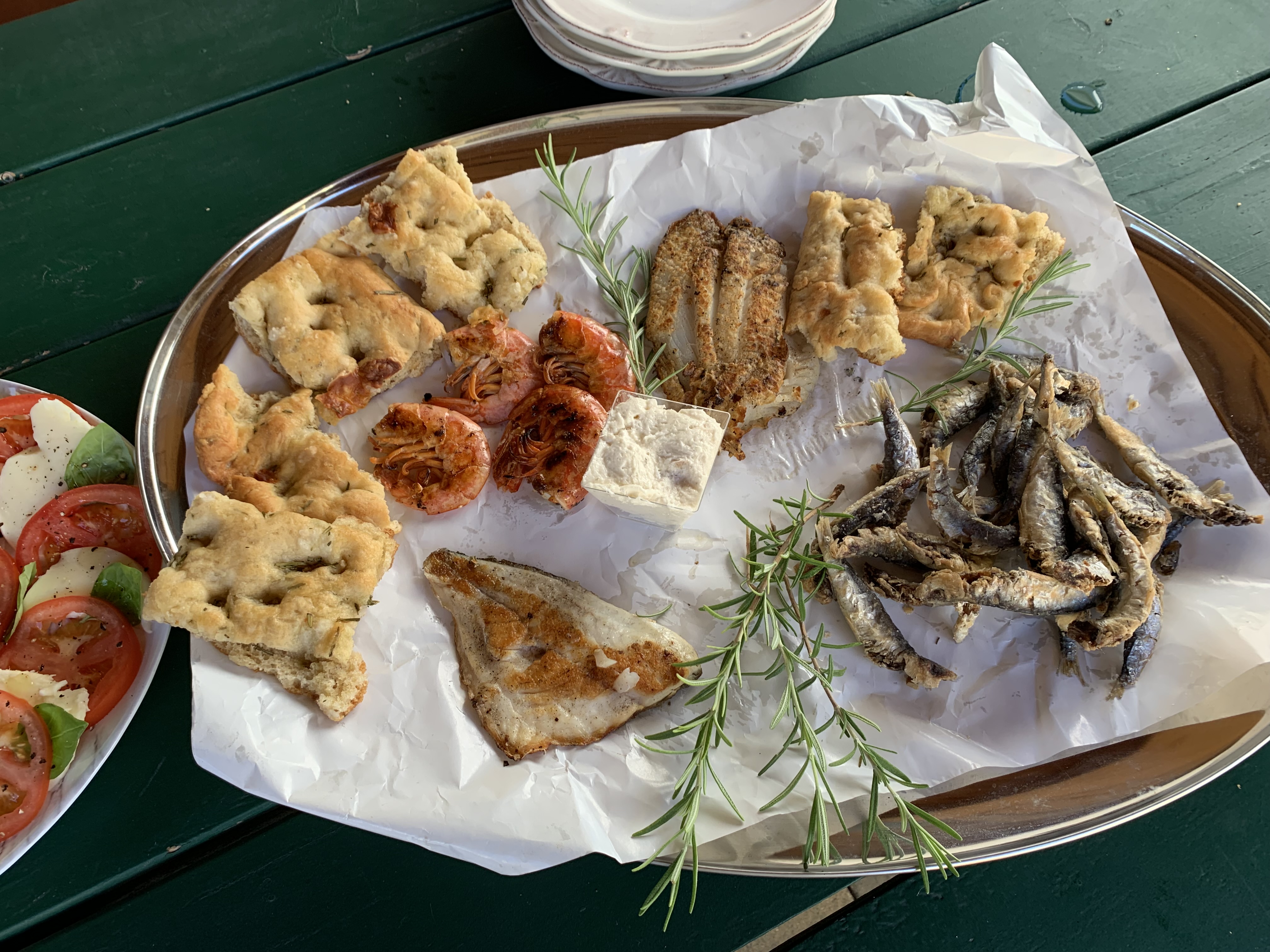
Our fish feast from the caravan, including mantecato. (Photo: Margot Patterson)
So, two Sundays in a row we selected a different array of freshly cooked fish, darted back home and gobbled it up. The Caorle caravan also sells little dishes of mantecato. We’ve decided it’s more fun and maybe even nicer than the rather formal, dress-up, hushed Braciere with its glittering crystal and silver.
In the caravan direction, in the opposite direction of what Mags calls Swan Lake and Ermes’ restaurant, is another local food and wine find. The modern-style chef and owner of the Carpacceria Goretti looks like chef David Higgs back in Jozi at Marble. He’s quite a health-conscious person, again like David and no doubt rides a bike too. Much of the food is, as the name says, carpaccio, as raw as possible. We drop in to see what it’s like and we stay, this time, for a couple of drinks and accompanying antipasto items.
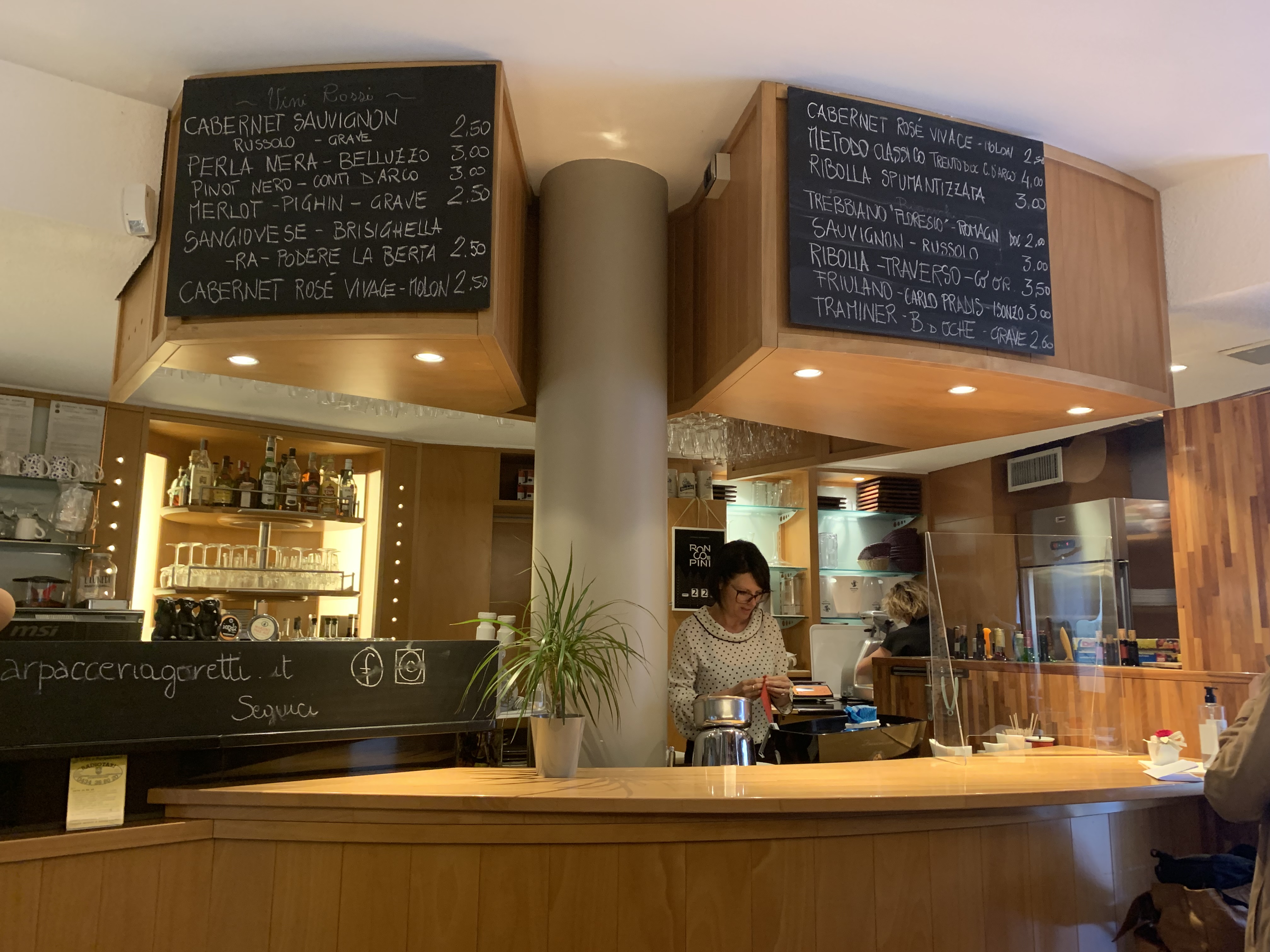
Carpaccieria Goretti. (Photo: Margot Patterson)
It’s all very well drinking the excellent proseccos created in the Veneto from glera grapes but this area even closer around us has some unique and interesting wines. Since it’s still warm, we choose to taste the whites this time. The Carapacceria Goretti prides itself on “simply different” wines. The young manageress tells us about them, she speaking broken English and I speaking broken Italian. It’s an amusing exchange especially for Mags who speaks both much better.
Before we start sipping, we’re both presented with a room-temperature but just-baked, perfectly-golden pulled-pork patty, lightly crumbed and redolent of fresh sage. With her help we choose a Ribolla Traverso, fresh green and flinty, something we think is like a Sauvignon. With it and matched to its taste, we receive freshly baked rolls with local prosciutto that apparently rivals San Daniele.
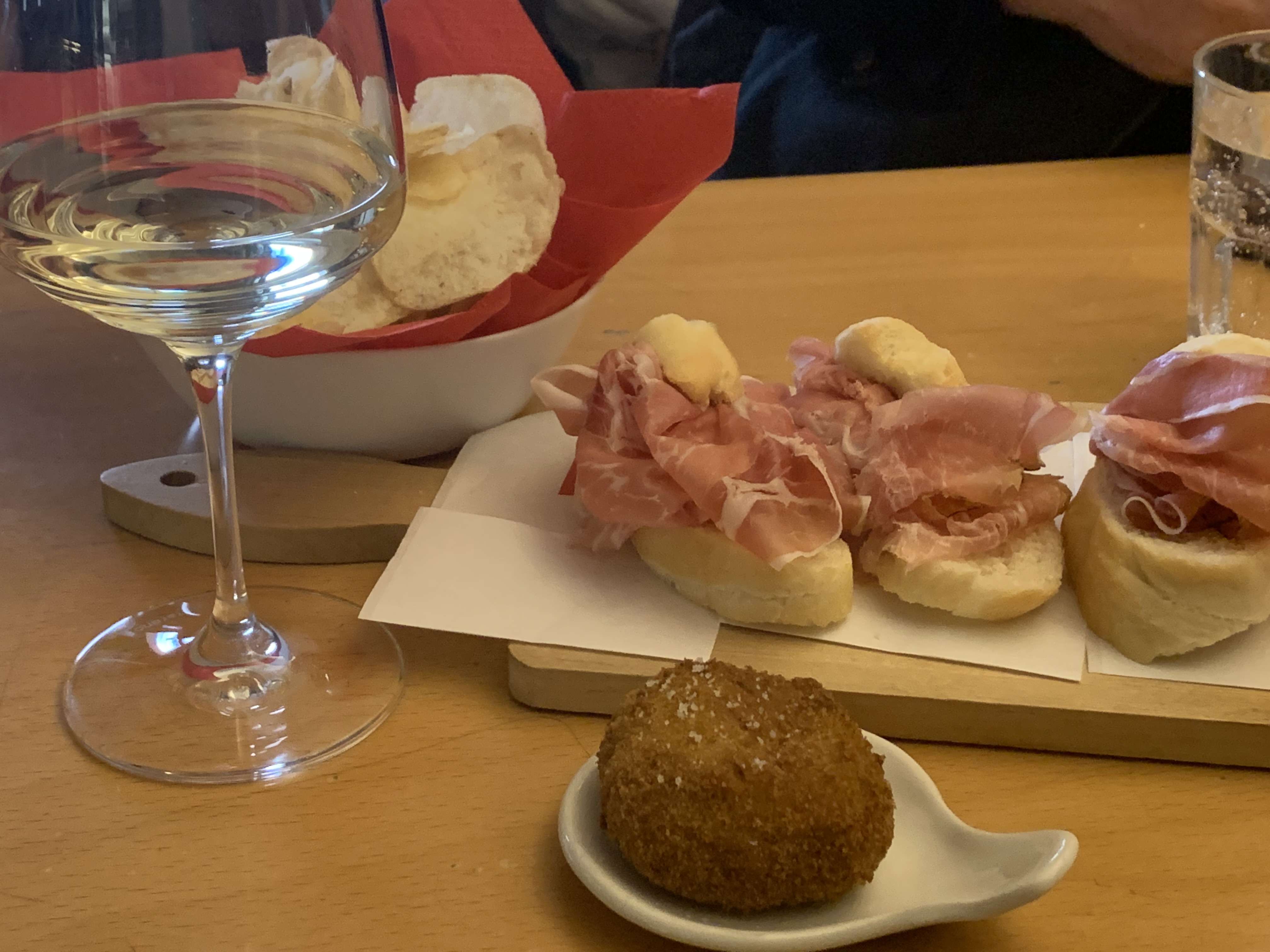
Fresh green and flinty Ribolla matched with rolls of local prosciutto. (Photo: Margot Patterson)
Our next wine is thanks to even more of her help. It’s a Friulano Carlo Paradis, most unusual, and has a strange duality of taste that starts off slightly bitter and warms into fruity aftertaste satisfaction. We’re thrilled by this discovery. We receive more matched snacks, these local ham with the surprise of horseradish atop, for which this area is apparently known. We didn’t know that. Next time we’ll have a real dinner here, judging by this experience.
Behind where the caravan is on Sundays is the local latteria or dairy we’ve also never gone into. Yes, here’s a great array again of local cheeses and also good gelato with lovely fresh flavours. I lick the lemon-basil one by way of a test. A week later there’s a pumpkin one for the change of season.
It’s made a great difference to my plans for my sister’s birthday. She’s asked me to make her a rabbit dish. To finish, she’s hinted she’d like gelato. I was going to cycle all the way into Porcia, the village close by, where there’s a well-known artisanal gelateria at the base of the castle. I was still working out how I’d get the gelato back without it melting and in time for pudd. If this one at the local latteria (across from the old palace gardens where we’ll have the bunny picnic) is not quite as artisanal, I am happily fooled and so it is the dessert course.
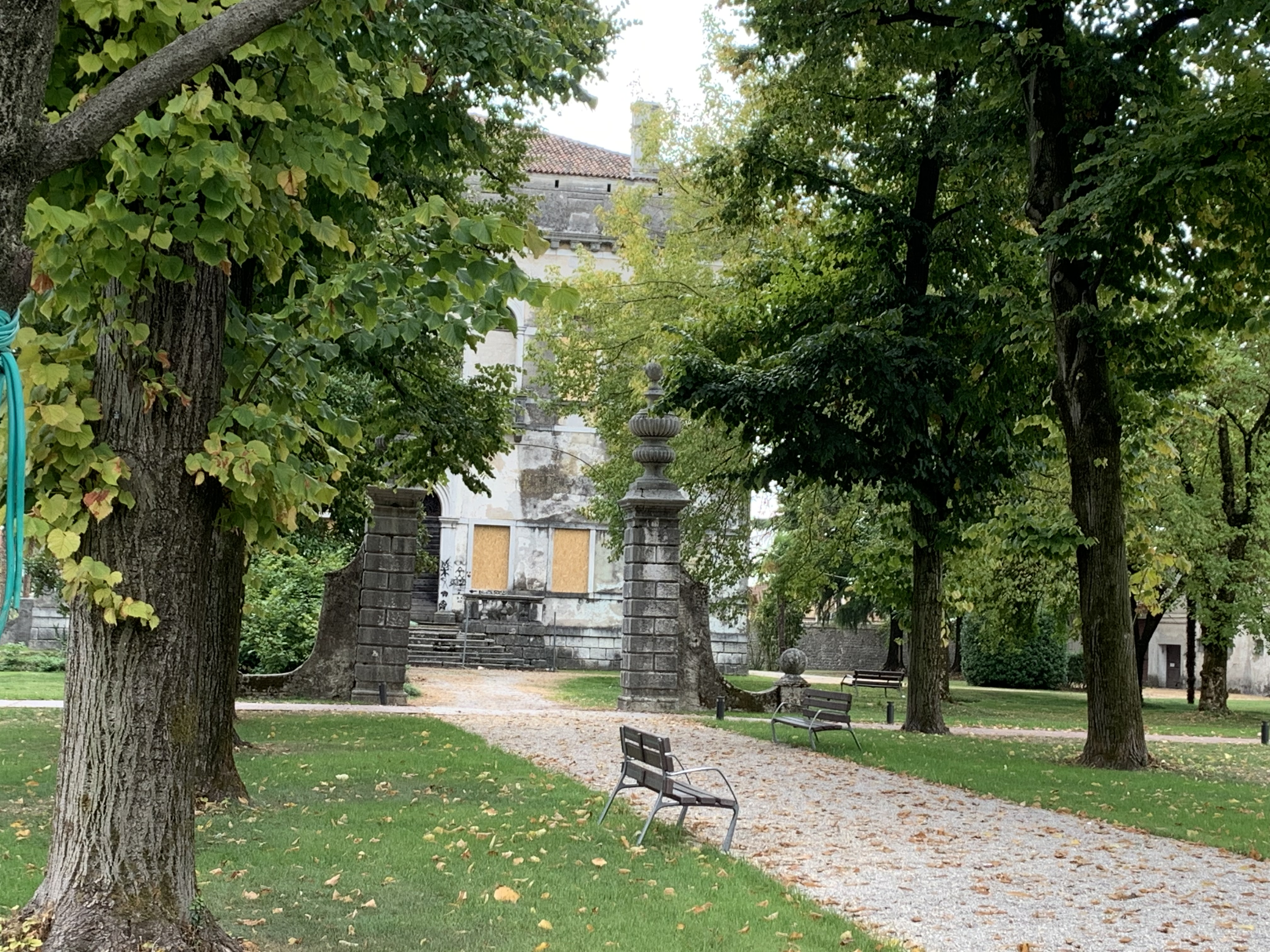
The old palace gardens where we have the birthday picnic. (Photo: Margot Patterson)
The rabbit dish starts out being vinegared for 12 hours in a huge white vase decorated with daisies. It’s the biggest container there is at the house. The butcher has provided me with extra heads for the sauce and I’m coming to terms with them. The bodies were not as difficult.
The local way of doing rabbit is more of a cacciatore style but I’m afraid mine is like a Sardinian sweet-sour sort of thing, with caramelised onion galore, green olives, capers and lots of local wine. Unfortunately, as I’m packing the finished hot dishes for the picnic, a friend pitches up with birthday greetings for Mags so I reheat everything again when she leaves. It’s not quite as I planned but isn’t bad with the mint-leafy-grilled zucchini. And the sauce rich with all the rabbit skulls that are now in the umido division of waste.
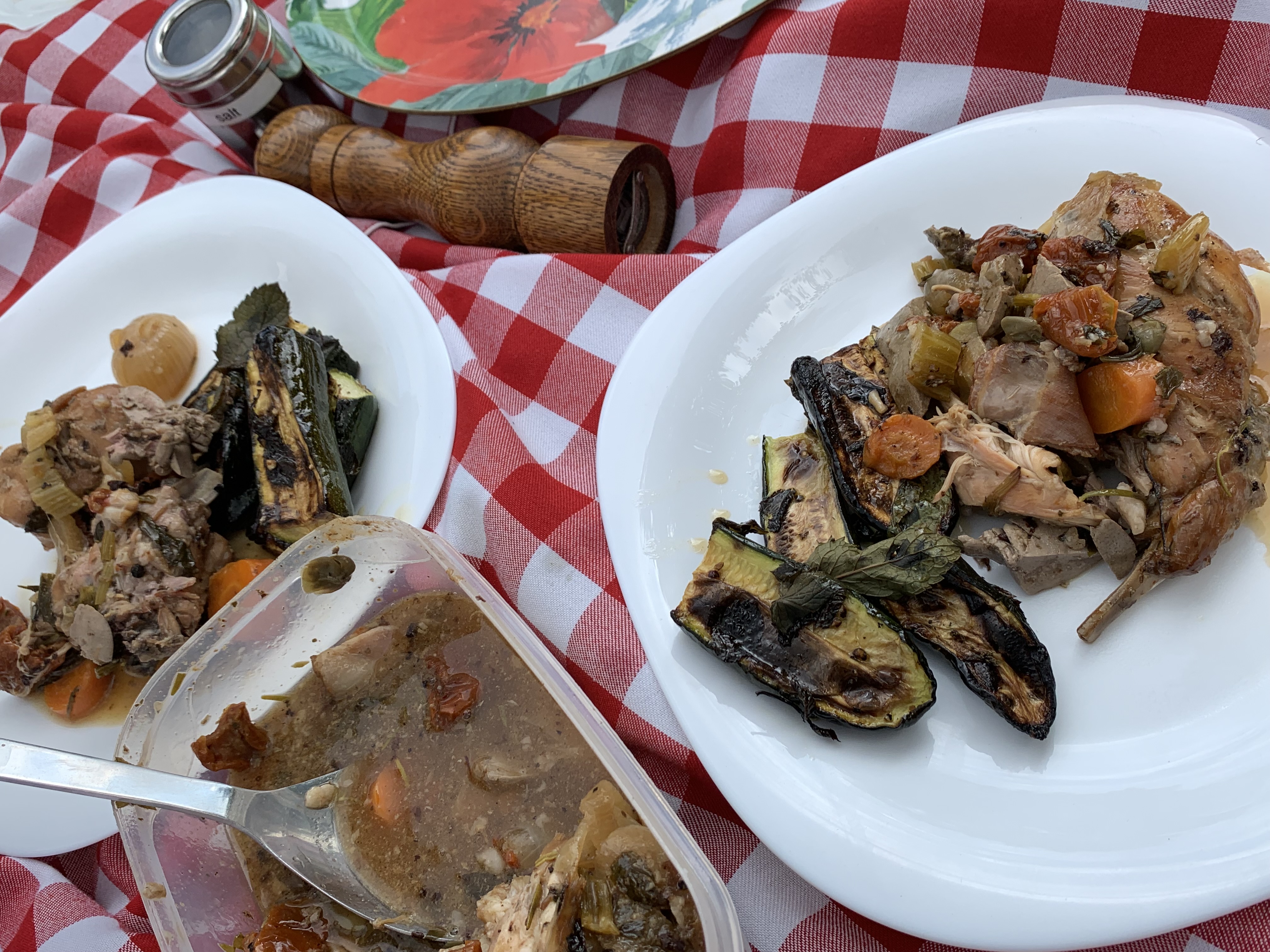
The rabbit is not quite as planned but tastes good with the minty zucchini. (Photo: Margot Patterson)
The domestic waste system is complicated and strict. If things are not perfectly sorted, the waste collector slaps a huge, vivid orange label onto your bag and then a fine if you’ve been naughty before.
Touching the super-seasonal fruit and vegetables is also not allowed. Still, I’ve worked out how to smell the ripeness of a melon without actually touching it. The contortion might not do much for the bella figura but this is Italy, well, this part of it. Italy is such a mixture of places of recently warring people that it’s no wonder the food in each area is so tightly and proudly protected.
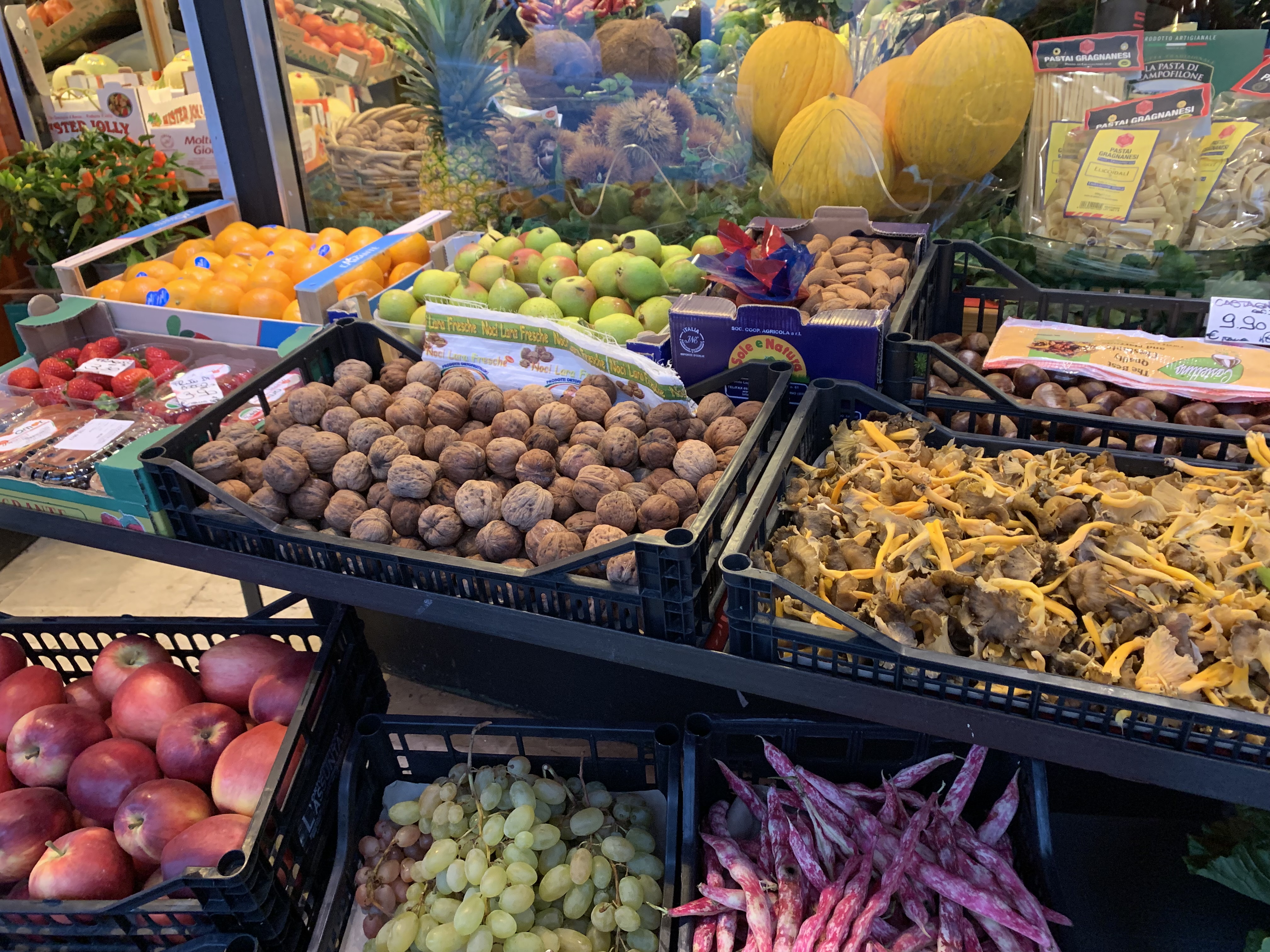
Touching the super-seasonal fruit and vegetables is also not allowed. (Photo: Margot Patterson)
Beautiful as my time has been, I always feel like kissing the friendly passport control officer on my return. We’re so different on our separate continents. It’s quite lovely to come home to Jozi. And a mielie. DM/TGIFood
The writer supports Nosh Food Rescue, an NGO that helps Jozi feeding schemes with food ‘rescued’ from the food chain. Please support them here.






 Become an Insider
Become an Insider
Comments - Please login in order to comment.